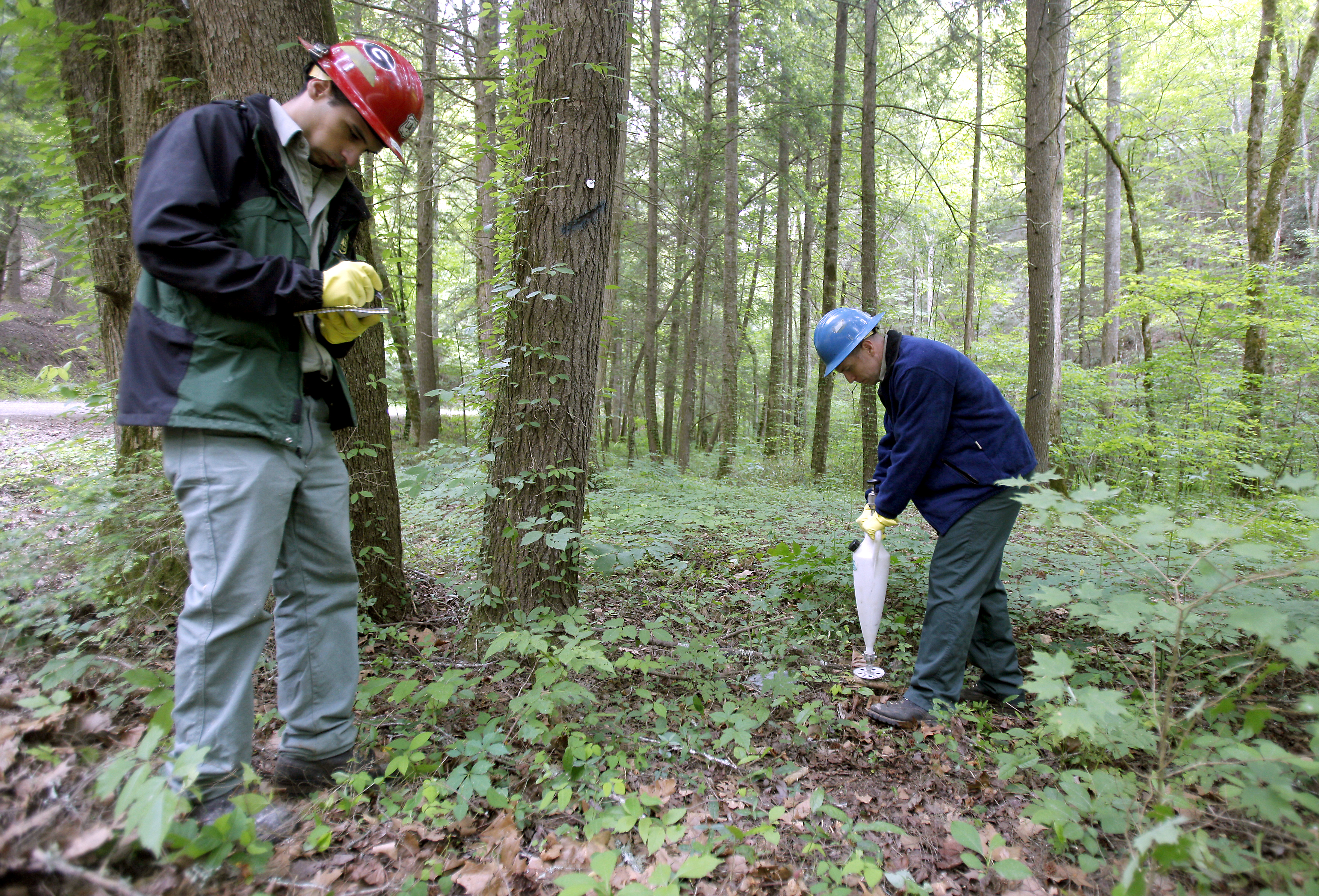Saving hemlocks
Saturday, May 21, 2011
 Jeremy Eubanks, forester trainee, takes notes on tree locations while Eric Taylor, forester, injects pesticide around the roots of a hemlock. Foresters with the Cherokee National Forest injected a pesticide around the base of hemlocks at the Lost Creek Campground, hoping to stop the destruction of the trees by hemlock wooly adelgids.
Staff Photo by Jake Daniels/Chattanooga Times Free Press
Jeremy Eubanks, forester trainee, takes notes on tree locations while Eric Taylor, forester, injects pesticide around the roots of a hemlock. Foresters with the Cherokee National Forest injected a pesticide around the base of hemlocks at the Lost Creek Campground, hoping to stop the destruction of the trees by hemlock wooly adelgids.
Staff Photo by Jake Daniels/Chattanooga Times Free PressCLEVELAND, Tenn.-Foresters with the Cherokee National Forest and its neighbor to the South, Chattahoochee-Oconee National Forest, are fighting to save the stately evergreen giants of the woods: eastern and Carolina hemlocks.
The trees, some hundreds of years old, are under attack by a microscopic bug that hitchhiked into the United States about 90 years ago from Asia - the hemlock woolly adelgid.
The sapsucking bugs drain the life from hemlocks in a matter of five to 10 years, according to experts.
"We aren't able to treat every tree, obviously," said forester Eric Taylor, who works in the Cherokee National Forest. "So we've prioritized some groups of trees scattered all over the forest to hopefully allow those groups to survive in the worst-case scenario. And we have lost a lot in certain places."
Cherokee and Chattahoochee forestry officials say they have spent about $100,000 on each forest this year, along with a lot of man-hours to treat the handful of hemlocks that have been prioritized by their location or their level of infestation.
The treatment is a combination of predator beetles that eat the adelgids and pesticide injected into the ground to be taken up by the trees' roots, eventually giving the sapsuckers a lethal tummy ache.
"The beetles are probably going to be our long-term equalizer. The pesticide is more of a Band-Aid until the beetle population builds up naturally," said Brian Jackson, forester with the Chattahoochee-Oconee National Forest.
Two types of predator beetles are being raised by the University of Tennessee and the University of Georgia, as well as several other college research departments. The beetles, about the size of ladybugs, cost about $1 apiece and can't be raised very quickly, experts have said.
The 650,000-acre Cherokee National Forest - the largest tract of public land in Tennessee - has 91 hemlock woolly adelgid treatment sites, Taylor said, and each treatment site has between a dozen and 150 hemlocks.
The Chattahoochee includes more than 750,000 acres, but foresters have had to prioritize treatment of hemlocks in 144 small sites of about nine acres each.
Jackson said most of the infestation is in the northern portion, especially the Blue Ridge and Chattooga districts. So far the infestation has not become so critical in the Conasauga district, he said.
Since 2006, Georgia has spent close to a half-million dollars trying to save the trees, said Mitch Cohen, Chattahoochee's acting public affairs officer.
"It's more than just saving a tree," he said. "It's actually saving the habitat in which those trees grow. It maintains a higher diversity of species in those areas, and that makes the ecosystem more stable in the long run."
The scenery and trout fishing provided by the hemlocks "is pretty important stuff," Cohen said.
"And we would lose them all if we didn't do anything," Jackson said.
The hemlock woolly adelgid arrived in North America from Asia in the early 1920s and first appeared in the Pacific Northwest, according to the U.S. Department of Agriculture.
In 1951, foresters found it in Virginia forests, and now it has spread to more than half the hemlock stands from New England to North Carolina, Eastern Tennessee and Northwest Georgia.
In Asia and the Pacific Northwest, the hemlock woolly adelgid is kept in check by predator beetles and other insects.
But in the eastern U.S., land managers are in a race against time to raise enough predator beetles to stop the adelgid.
Bruce Kauffman, president of the Tennessee Entomological Society and senior technician with the University of Tennessee's soil, plant and pest lab, has said the bug will spread over the Cumberland Plateau within this decade, carried by wind, deer, birds, even people who brush against infected foliage.
"There's been a collection of seed so the [hemlocks] will not go extinct," he said. "But when we have hemlock deaths, we lose stream shade and raise water temperature in streams that support trout, other aquatic organisms and birds that build in [dense] cover. We don't have a replacement for that."
